A 49-year-old man with persistent wrist pain, weakness
A 49-year-old man who was right-hand dominant presented with persistent right wrist pain and weakness 6 months after slipping and falling on ice while hiking in Iceland.
The patient had immediate wrist pain and swelling but did not seek treatment at the time. A professional photographer, he reported difficulty lifting equipment of more than 10 pounds. He had no other medical problems, but he was an active smoker.

On examination, there was mild dorsoradial wrist swelling and maximal tenderness over the scapholunate (SL) interval. Wrist flexion and extension were minimally decreased on the right side compared with the left. Neurovascular exam was normal. Watson shift test was positive with a painful clunk. Radiographs of the wrist demonstrated SL widening and an increased SL angle on the lateral (Figure 1).
What is your diagnosis?
See answer on below.
Scapholunate interosseous ligament disruption
The diagnosis of SL interosseous ligament disruption was made based on the physical exam and radiographic findings. An increased SL interval (>5 mm), often referred to as the Terry-Thomas sign, is a classic radiographic finding following complete SL interosseous ligament (SLIL) injury. On the lateral radiograph, the SL angle was noted to be abnormally large (>70° is considered abnormal), further confirming the diagnosis. Disruption of the SL ligament leads to scaphoid flexion and lunate extension, which is called dorsal intercalated segment instability (DISI). The additional capitate migration proximally and loss of carpal height indicated injury or attenuation of the secondary stabilizers of the SL interval, either from the severity of the initial injury or chronicity of the injury.
Preferred treatment
Given the patient’s young age, active lifestyle and limited arthritis, he was indicated for SLIL repair vs. reconstruction. The patient wished to maintain maximal wrist range of motion to allow him to continue his occupation as a professional photographer. Intraoperatively, the deformity was reducible and there was no significant radioscaphoid arthritis. High-quality ligamentous tissue was found still attached to the scaphoid. Therefore, the decision was made to proceed with primary repair of the ligament back down to the dorsal lunate with subsequent pinning of the carpus. Intraoperative fluoroscopic images demonstrated reduction of the deformity and reconstitution of normal carpal alignment (Figure 2).
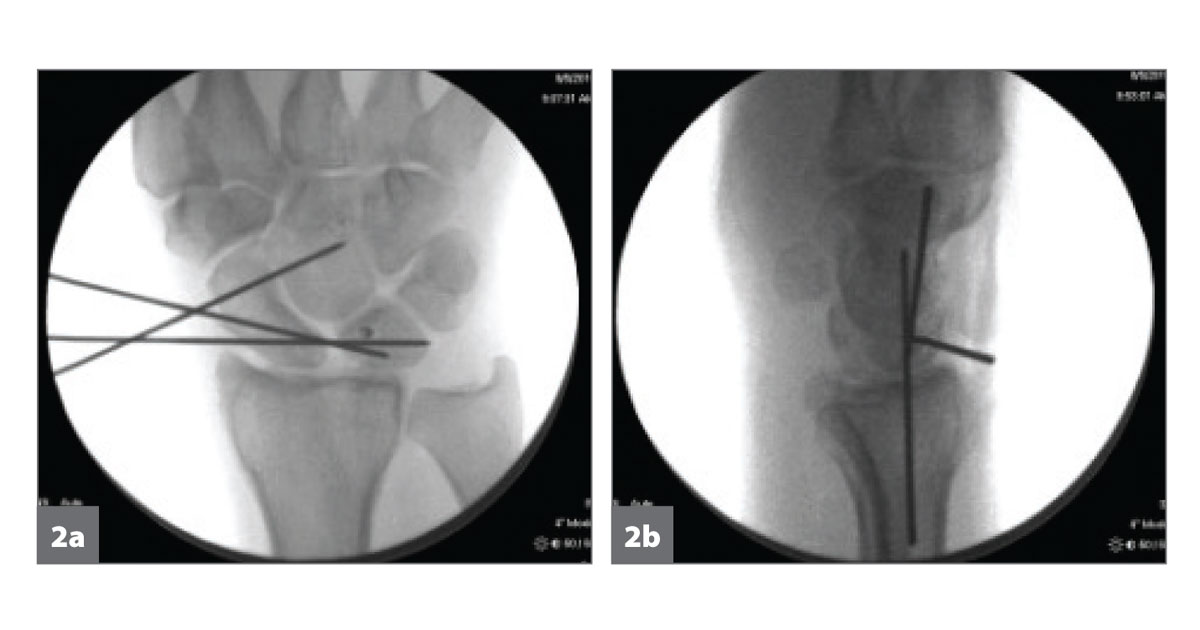
At the first postoperative visit 2 weeks later, posteroanterior (PA) and lateral radiographs demonstrated relative maintenance of carpal alignment, but at least one of the K-wires had migrated (Figure 3). There was no evidence of infection on examination and the patient had minimal pain. After a discussion of options, the decision was made to apply a short arm cast.
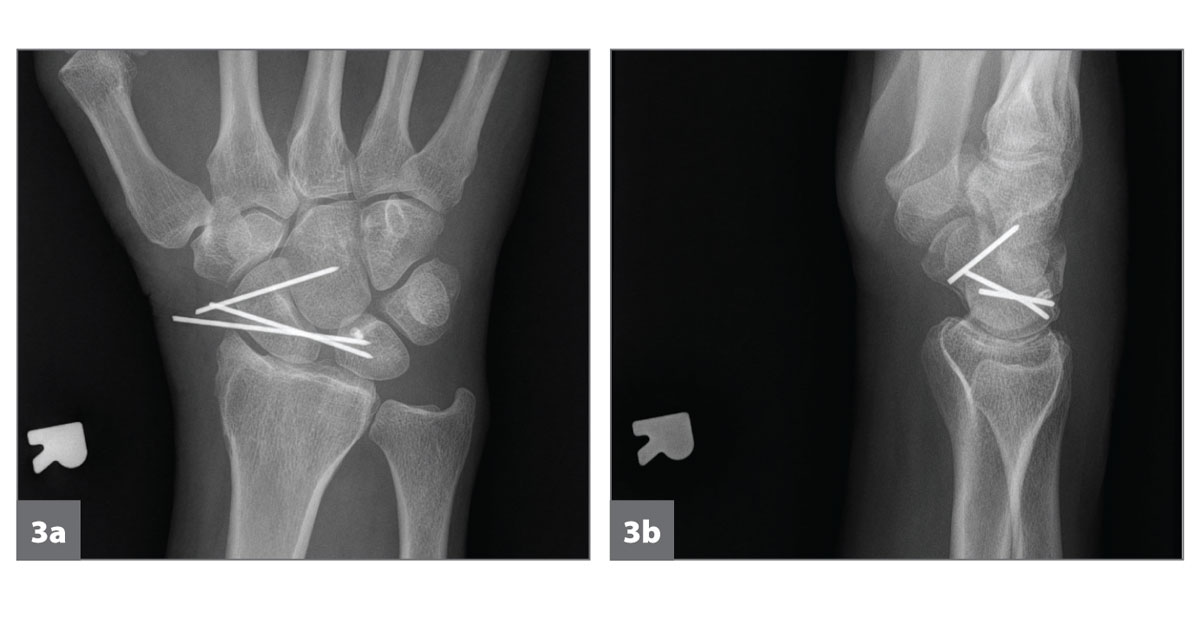
The patient returned 4 weeks later for routine follow-up and had noted increased radial-sided wrist pain. PA and lateral radiographs at this time demonstrated complete failure of the repair and recurrence of the carpal malalignment (Figure 4). One of the K-wires had migrated out of the skin and there was surrounding erythema and induration. Following an unsuccessful attempt to remove the other two K-wires in the office, the patient returned to the OR for K-wire removal. At the time of surgery, there was no evidence of deep infection and the patient was discharged home on a course of oral antibiotics following the successful removal of the wires. Immediate reconstruction was considered but ultimately delayed due to the concerns for placing new hardware in the setting of infection.
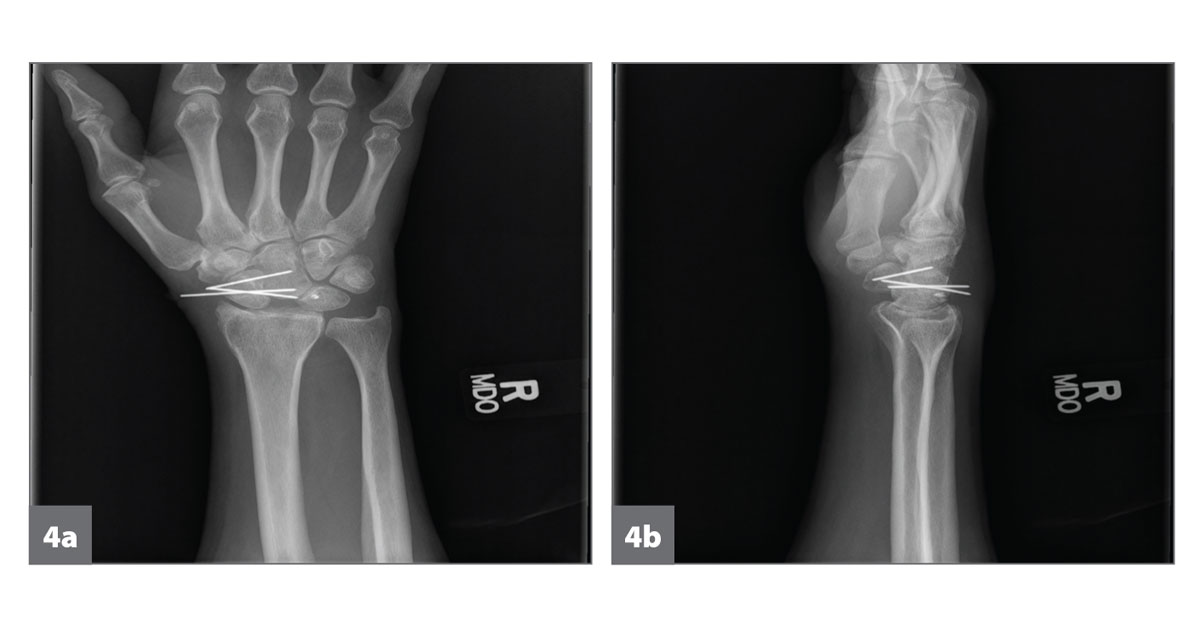
Two weeks following removal of hardware, all signs of potential infection had resolved and repeat radiographs demonstrated SL interval diastasis and recurrence of the DISI deformity (Figure 5). An extensive discussion of options including observation, SL reconstruction with or without capsulodesis, and salvage procedures was undertaken. The patient wished to avoid a limited wrist fusion or proximal row carpectomy and elected to proceed with a reduction and association of the scaphoid and lunate (RASL) procedure. This technique involves reduction of the SL joint and transfixion via a partially threaded headless compression screw. The goal of the procedure is to create a fibrous union between the scaphoid and lunate to allow anatomic micromotion at this joint. At the time of surgery, there was no evidence of infection and the deformity was easily reducible. Intraoperative images from the RASL procedure demonstrated satisfactory placement of the screw and reduction of the scaphoid and lunate (Figure 6).

At the first postoperative visit 2 weeks after the RASL procedure, radiographs demonstrated complete failure of fixation (Figure 7). At this point, three primary options were discussed, including leaving the hardware, simply removing the screw and waiting for degenerative changes, or removing the screw and proceeding with a salvage procedure. The patient was unhappy with his grip strength and was not interested in leaving his wrist the way it was prior to the initial procedure. Therefore, he and the surgeon agreed to proceed with one final, definitive procedure. Given his young age, a scaphoidectomy and four-corner fusion were chosen. The procedure was uncomplicated (Figure 8).
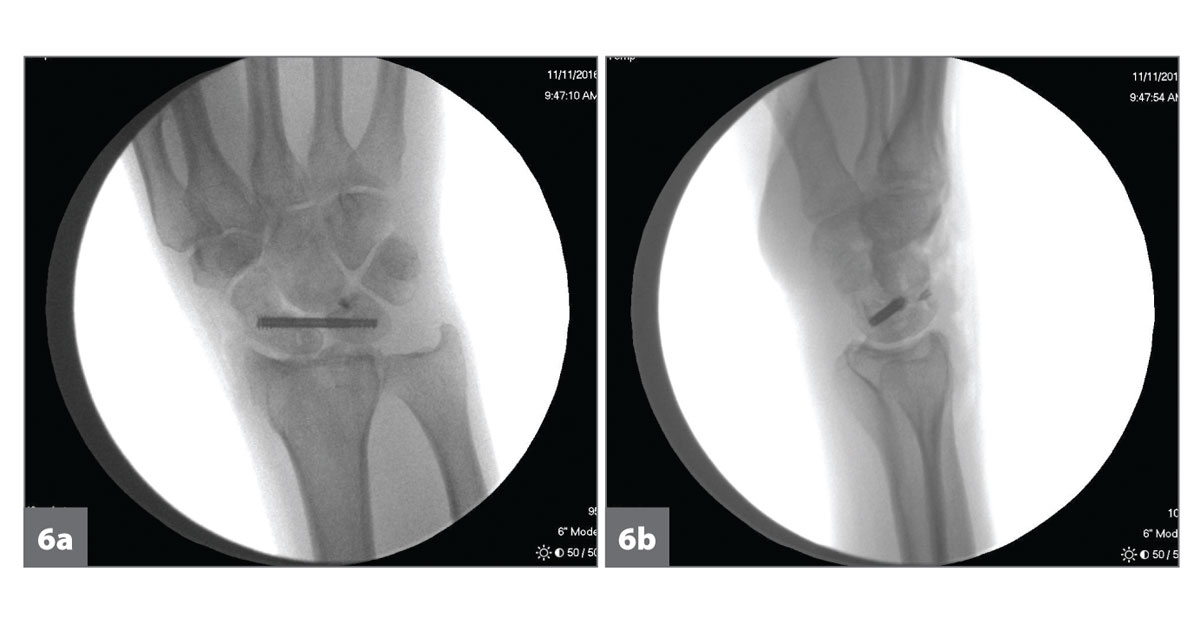
The patient also had an uncomplicated postoperative course after the four-corner fusion. Radiographs at 7 weeks demonstrated expected hardware positioning with appropriate fusion mass (Figure 9). A subsequent CT scan confirmed successful fusion. At final follow-up, the patient demonstrated near symmetric wrist range of motion and had full, normal use of the wrist without pain.
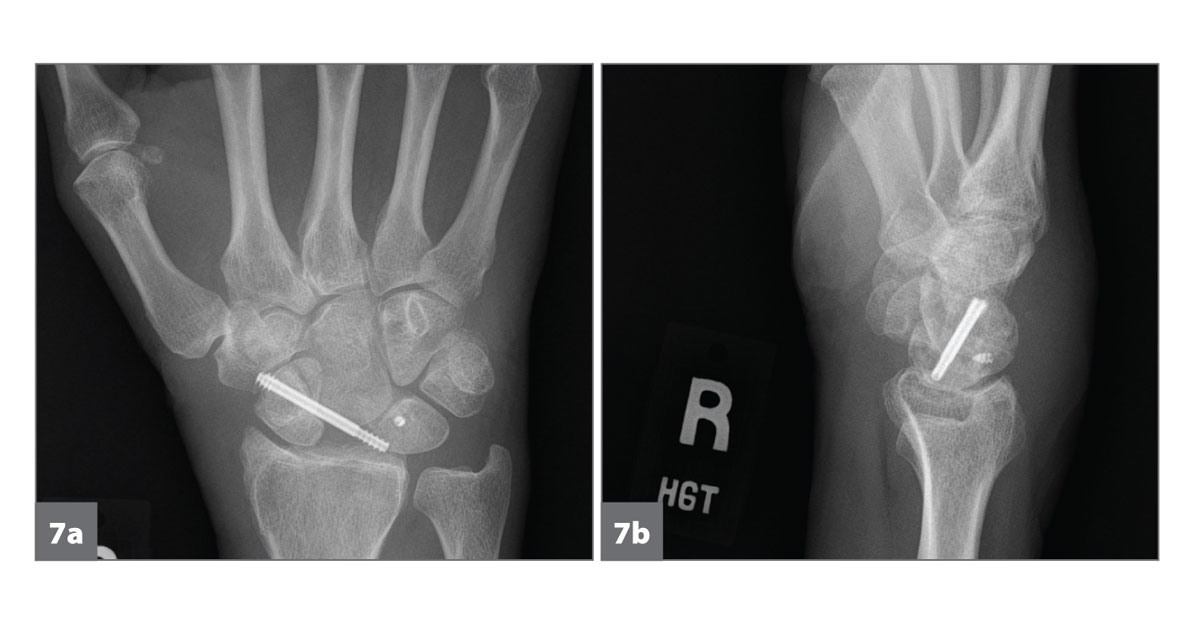
Case discussion
The SLIL is an intrinsic carpal ligament composed of dorsal, volar and proximal components. Dorsally, it is taut with parallel collagen fibers running transversely between the scaphoid and lunate, which provides the majority of the tensile strength. The dorsal component’s importance in SL stability has been demonstrated in cadaveric sectioning studies. There is also a high density of mechanoreceptors in the SLIL, suggesting a possible role in the regulation of dynamic carpal stability.
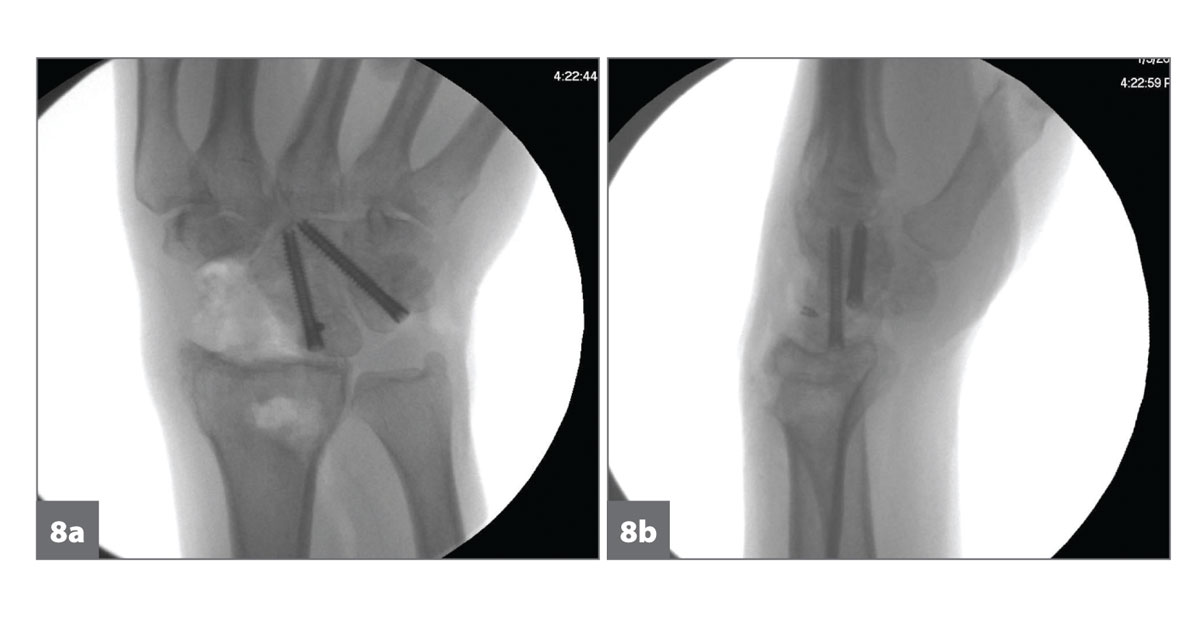
Injury to the SLIL, particularly its dorsal component, leads to an alteration in carpal kinematics. Without the SLIL, the scaphoid and lunate dissociate with the scaphoid falling into flexion and the lunate into extension. This combination of scaphoid flexion and lunate extension, known as DISI, is the most common type of carpal instability. The abnormal flexion of the scaphoid leads to an alteration in the transmission and distribution of forces across the radioscaphoid joint. This results in the development of degenerative changes initially in the dorsolateral corner of the scaphoid facet. Using 3D in vivo models of DISI deformity secondary to SLIL disruption, Shinsuke Omori, MD, and colleagues showed dorsoradial translation of the scaphoid increases the contact pressure on the dorsolateral rim of the radius, potentially leading to degenerative change. The arthritis can progress to the entirety of the scaphoid facet followed by destruction of the midcarpal joint and ultimately lead to pan-carpal arthritis. This well-defined sequence of arthritis is called SL advanced collapse. Surgical treatment of SLIL injuries attempts to limit this progression.
Patients with SL instability present with pain or weakness with loading of the affected wrist. Pain is typically located on the dorsal central aspect of the wrist. The patient’s history may or may not include an obvious injury. Clinical examination typically reveals a decrease in grip strength and range of motion relative to the contralateral side. The Watson shift test can demonstrate SL instability; with volar pressure on the distal pole of the scaphoid, the wrist is passively moved from ulnar to radial deviation. If the SL ligament is completely ruptured or incompetent, the proximal pole of the scaphoid subluxates dorsally, inducing pain or a clunk in the wrist.
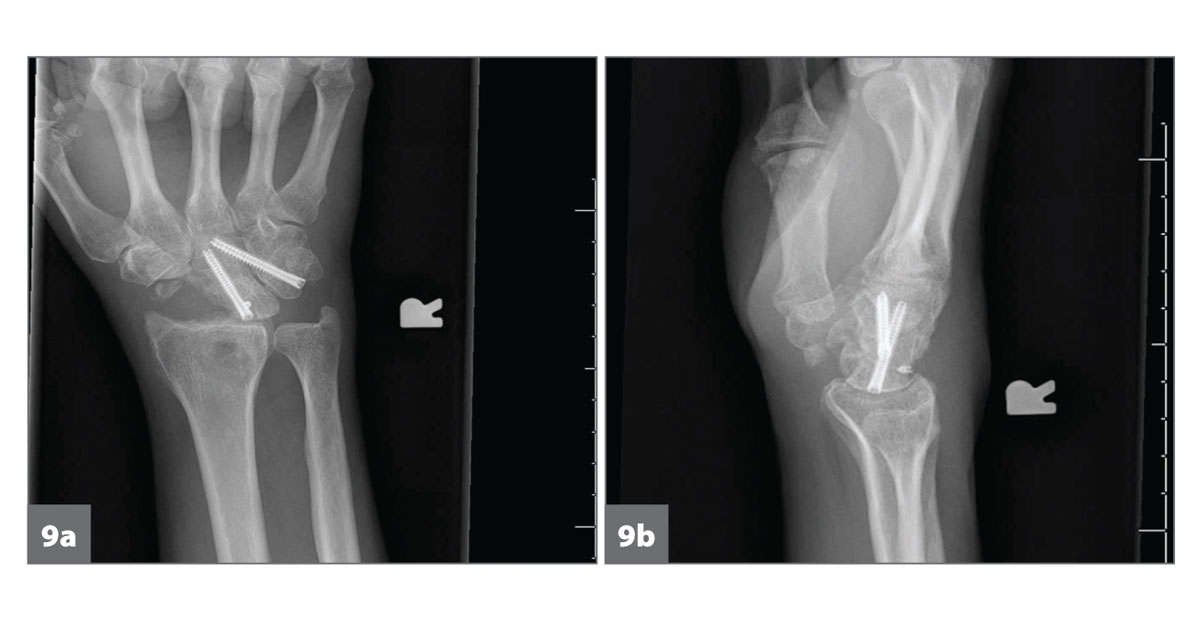
There are a number of nonoperative and operative treatments aimed at managing subacute and chronic SLIL injuries. Marc Garcia-Ellis, MD, proposed a treatment algorithm based on the timing of the injury, presence of static or dynamic carpal malalignment and the presence or absence of arthritis. For patients with occult instability, arthroscopic intervention is both diagnostic and therapeutic. Ligamentous debridement and thermal capsular shrinkage can successfully treat partial SL tears and provide good short-term results. For patients with dynamic instability, as demonstrated by widening of the SL interval on PA clenched-fist radiographs, timing of the injury (acute, acute-on-chronic or chronic) will largely dictate surgical treatment. In general, chronic injuries will require reconstruction with or without capsulodesis and acute injuries should be primarily repaired. If the tissue is not amenable to repair, reconstruction is required. In subacute cases, dynamic instability can be treated with direct repair with K-wire supplementation with or without capsulodesis. Riccardo Luchetti, MD, and colleagues reported significantly decreased pain scores and improved grip strength in all 18 chronic SLIL dissociations treated with dorsal intercarpal capsulodesis. For patients with reducible SLIL disruption but an unrepairable SLIL, surgical options include SLIL reconstruction using local tissue, tendon or ligament autograft or allograft, or suture material; internal fixation, such as the RASL procedure; or a salvage procedure. Garcia-Elias and colleagues found nearly 75% of patients returned to their pre-injury occupational status and reported improved pain levels following tendinous reconstructions. Salvage options, which are primarily indicated once arthritis has developed, include proximal row carpectomy and four-corner fusion.
This case illustrates the difficulty in managing these challenging injuries. For an unrepairable SLIL, the RASL procedure provides a treatment option that improves wrist function while maintaining range of motion. In a 2012 article, Martín Caloia, MD, and colleagues noted an improved pain score and grip strength that was 78% of the reported contralateral side. However, five RASL failures in eight wrists have been reported by Timothy B. Larson, MD, and colleagues. One of the failures was due to “immediate backing out of the headless compression screw,” but no images of this failure were provided. Perhaps the significant static, chronic deformity our patient initially presented with predicted the failure of the attempted primary repair and the failure of the RASL procedure. Fortunately, the four-corner fusion salvage procedure provided the patient with a good functional outcome. Although the patient was a smoker, we opted for a fusion procedure rather than proximal row carpectomy both due to concerns about subsequent arthrosis at the radiocapitate joint in a relatively young, active patient and in an effort to optimize grip strength. Although no studies have definitively shown superiority of one salvage procedure over another, Bryan M. Saltzman, MD, and colleagues reported four-corner fusion resulted in significantly greater postoperative radial deviation and grip strength compared with proximal row carpectomy, whereas the proximal row carpectomy resulted in an improved flexion-extension arc.
As demonstrated by this case and discussion, chronic SLIL is a difficult disease process to manage with no superior surgical option. In the absence of clear consensus on the best surgical options for chronic SL injuries, shared decision-making and surgeon experience becomes paramount. Ultimately, the chosen treatment should be dictated by a discussion with the patient about the lack of a gold standard and potential for failure of any of the available options.
- References:
- Bain GI, et al. J Wrist Surg. 2012;doi:10.1055/s-0032-1329548.
- Bednar JM, et al. J Am Acad Orthop Surg. 1993;doi:10.5435/00124635-199309000-00002.
- Brunelli GA, et al. Rev Chir Orthop Reparatrice Appar Mot. 2003;89:152–157.
- Caloia M, et al. Clin Orthop Relat Res. 2012;doi:10.1007/s11999-011-1953-4.
- Danoff JR, et al. Hand Clin. 2011;doi:10.1016/j.hcl.2011.06.005.
- Garcia-Elias M, et al. J Hand Surg Am. 2006;doi:10.1016/j.jhsa.2005.10.011.
- Garcia-Elias M. Wrist instabilities, misalignments, and dislocations. In: Green’s Operative Hand Surgery. Vol. 7. Philadelphia, PA. Elsevier/Churchill Livingstone; 2017:417–478.
- Kitay A, et al. J Hand Surg Am. 2012;doi:10.1016/j.jhsa.2012.07.035.
- Larson TB, et al. J Hand Surg Am. 2014;doi:10.1016/j.jhsa.2014.07.014.
- Luchetti R, et al. J Hand Surg Eur Vol. 2010;doi:10.1177/1753193409347686.
- Mataliotakis G, et al. J Hand Surg Am. 2009;doi:10.1016/j.jhsa.2009.05.007.
- Omori S, et al. J Hand Surg Am. 2013;doi:10.1016/j.jhsa.2013.04.004.
- Saltzman BM, et al. J Hand Surg Eur Vol. 2015;doi:10.1177/1753193414554359.
- Watson HK, et al. Hand Clin. 1997;13:39-49.
- Watson HK, et al. J Hand Surg Am. 1988;doi:10.1016/s0363-5023(88)80118-7.
- White NJ, et al. J Am Acad Orthop Surg. 2015;doi:10.5435/JAAOS-D-14-00254.
- For more information:
- Curtis M. Henn, MD, and Jay L. Mottla, MD, can be reached at MedStar Georgetown University Hospital, Department of Orthopaedic Surgery, 3800 Reservoir Road NW, Washington, DC 20007. Henn’s email: curtis.m.henn@gunet.georgetown.edu. Mottla’s email: jay.l.mottla@gunet.georgetown.edu.
- Jordan P. Murphy, MD, can be reached at Georgetown University School of Medicine, 3900 Reservoir Road NW, Washington, DC 20007; email: jpm338@georgetown.edu.
- Edited by Joshua D. Johnson, MD, and Nicholas A. Trasolini, MD. Johnson is a chief resident in the department of orthopedic surgery at Mayo Clinic in Rochester, Minnesota. He will be a musculoskeletal oncology fellow at MD Anderson following residency. Trasolini is the administrative chief resident in the department of orthopedic surgery at Keck Medical Center of the University of Southern California and will be a sports medicine fellow at Rush University Medical Center following residency. For information on submitting Orthopedics Today Grand Rounds cases, please email: orthopedics@healio.com.
